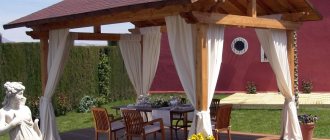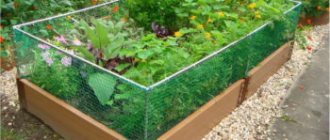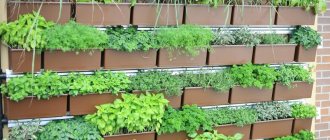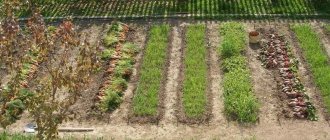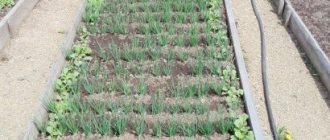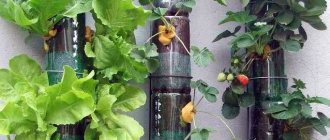Features of stone beds
Decorating the planting area with stone fences allows you to give the beds almost any shape - round, square, rectangular, in the form of stars, animals and various objects. It is not necessary to follow only straight lines and regular contours. With the help of stones, you can make the most effective use of garden soil and bypass difficult areas, passing them off as original author's ideas. The photo shows beds made of stone of unusual shape, created with your own hands.
Important! Beds made of stones should be of such dimensions that you can easily reach the middle. Large beds are less easy to maintain.
Standard beds are no more than 1 m wide, 1.5 m long and 30 - 50 cm deep. There should be a retreat of 0.5 m between the rows. The surface layer of the stone beds should be 30 - 50 cm above the level of the paths.
Stones can be used in completely different types, colors and sizes, depending on personal preferences and financial capabilities. Both natural stone with torn edges and artificial stone, which has a more refined appearance, are suitable for decorating beds and flower beds. The following material can be used for the construction of stone fences:
- Basalt - a volcanic rock resistant to mechanical stress will perfectly protect seedlings from damage;
- Pebbles are stones that differ in shape and color, but have a rounded surface, ground with water. Very often they are used in garden plots for decorative purposes and to decorate garden objects;
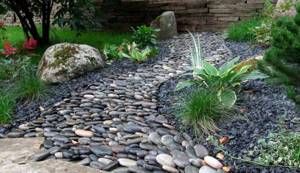
- Limestone - has a porous structure and over time becomes covered with moss, which organically fits into the overall landscape design;
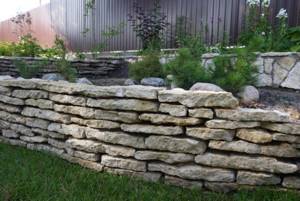
- Sandstone is not a very durable material. But it has good breathability and provides additional aeration for plant roots. A wide color palette allows you to decorate the garden bed in accordance with the planted plants;
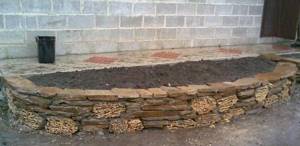
- Granite is one of the most beautiful and durable stones. But, despite its advantages, it is rarely used to create beds from stone, due to its high cost and ability to oxidize the soil.
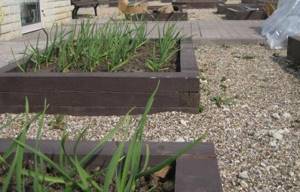
Stone masonry beds have a special glossary of terms. The edges of the stone that are in contact with other objects on the upper and lower sides are called beds, the long side edge is called spoons, and the short one is called poke. Stones facing the outer surface of the wall with a long edge are called a spoon row. Turned with a short edge - tychkovy.
When choosing to design beds with stones, you should know about all the advantages and disadvantages of using them.
"Keyhole"
A walkway to the center gives access to the entire garden bed.
A very interesting design option for raised beds is a circle with a passage to the center. When viewed from above, the outline of the structure will resemble a keyhole, which is why it received its name. This shape is convenient because it gives easy access to the entire bed, unlike completely round ones, the center of which is difficult or impossible to reach. Another advantage of such a structure is the ability to arrange a compost pit right in the center of the bed.
You can set up a compost heap in the center.
Interesting fact: The idea for this interesting garden bed came from Africa, from where it quickly spread throughout the world. In hot and dry climates, this form allows you to retain precious moisture, and the compost heap covers the entire bed. Therefore, in Africa, the “keyhole” is located near the kitchen, so that it is convenient to immediately compost leftovers after cooking.
Advantages and disadvantages of fencing beds with stones
Fencing for garden beds performs the following main functions:
- protection of planting soil from erosion during precipitation or watering;
- creating a natural barrier to the spread of weeds;
- limiting the growth of planting crops;
- safe fencing of cultivated plants during grass cutting;
- improving the overall appearance and design of the garden plot.
Beds made from natural or artificial stone successfully cope with all their goals. Such structures are durable and do not crumble.
The main advantages of their use include:
- relatively low cost;
- presentable appearance;
- strength;
- long service life.
The main disadvantages include:
- a standard range of colors and shades, not very diverse;
- the need for regular maintenance - annual renewal and strengthening of beds;
- complexity of manufacturing.
One of the inconveniences associated with using stone beds is that they sag in the ground over time. This situation leads to the need to dismantle the entire structure, add soil and restore the boundaries.
Made of brick
Brick beds are all about style and practicality.
Beds made of brick look no less impressive than those made of stone. This is also not a cheap pleasure, but you can use old bricks if some kind of building is being dismantled. In addition, you will have to make efforts to get a reliable high structure. Brick, like stone, is not enough to just be dug into the ground; it will be necessary to build a foundation, only then will the bed last a long time.
For beds, you can use bricks from old buildings.
Beds made of curb stones
Curb stone is made from concrete and is a rectangular tile of various colors. The material can have rounded edges and can be used in any design of garden beds. Before using curb stones, you need to decide on the purpose of the installation.
To fence off a plot of land with large flowers or seedlings, a tall structure about 0.5 m high is erected. In order to decoratively highlight the beds, it is enough to lay out a low border strip in a certain, pre-thought-out sequence.
The technology for laying curb stones includes several stages:
- Preliminary marking of the future bed is carried out. To do this, pegs are driven in around the perimeter and a rope is pulled.
- They dig a ditch. When calculating its width, you need to add 2 cm to the width of the curb stone. The depth should not exceed 30 cm.
- Fill the trench with a mixture prepared from 3 parts sand and 1 part cement with gradual addition of water until the consistency of thick sour cream is obtained. There should be at least 10 cm from the top level of the poured mixture to the edges of the trench.
- The curb stone is placed in the solution with slight pressure. A rubber mallet will help to deepen it slightly. It is necessary to ensure that the resulting row is even both horizontally and vertically. To do this, you can use a building level.
- After the work has been done, you should return to the beginning of the bed and fix the stones. To do this, small portions of the remaining cement mortar are stuck to the base of the stones. In this case, slides 5 cm high are formed along the edges of the bed.
After this, the plot of the bed can be decorated with gravel or sand. The only disadvantage of such a fence is the high cost of curb stones. The photo shows options for laying beds made of curb stone.
Important! To increase the durability and strength of stone fences, all existing voids between the stones should be filled with connecting mixtures.
How to make beds from stones with your own hands
Creating beds from stones does not require experience or specific knowledge. Before performing work, it is necessary to carry out preliminary preparations and adhere to a certain sequence of actions.
Plants can be planted a few days after the soil has completely settled, after adding fertile soil. When planting seedlings, remember that the surface of the stone bed must be located strictly horizontally. This will prevent excess fluid from accumulating in the low level.
Laying stone fencing can be done wet or dry, depending on whether a bonding mortar is used as a connecting link or not.
Building a garden bed using dry stone laying
When laying in this way, it is necessary to carefully select the stones and adjust their size to each other with extreme precision. The difficulty in working with natural stones is due to the fact that each of them has individual geometric shapes. This requires additional skills and knowledge. Stones in contact with the vertical side must be laid in compliance with the maximum area of contact. Incorrectly folded masonry elements will sooner or later lead to the destruction of the entire structure.
The technology of laying in one row is quite simple. Large stones of equal size are pressed along the perimeter of the bed very tightly to each other. In this case, the use of concrete will not be required. The fence will be level and quite stable.
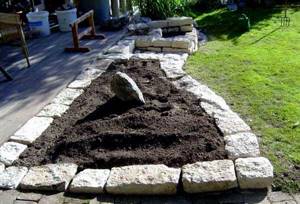
To ensure the reliability of stone beds built in several rows using the dry laying method, it is necessary to alternate spoon and butt rows. Empty spaces can be filled with sand, earth or small pebbles.
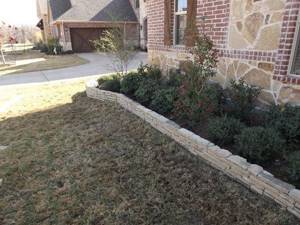
This installation method is only suitable for low decorative fences. If it is necessary to erect a high structure, you should resort to the “wet” option.
Building a bed with cement
This method is characterized by relative simplicity and reliability, and therefore is most common among gardeners and summer residents. Recommended for the construction of large and high stone beds. The use of a connecting mortar that fills all gaps and voids gives the stone beds monolithic strength and stability.
Precise adjustment of the size of the stones in this case is not of paramount importance, but their correct combination with each other will greatly facilitate the work. This design looks more respectable and in the process of laying equal stones, consumable binding materials are saved.
The construction of a bed using the wet method is carried out in several stages:
- Select a suitable location and calculate the required quantity and type of fencing material. Outline the contours of the future bed.
- Dig a trench 20–30 cm deep to create a foundation.
- Ruberoid or polyethylene is laid on the bottom and filled with cement mortar. If it is missing, you can place geotextiles in the recess, fill it with sand 1/3 and compact it.
- First, large stones are laid on the dried solution, adjusting them to shape. The remaining cracks are filled with a cement solution with the addition of crushed stone and fine gravel to give strength. Several holes are left in the bottom layer for air circulation.
- While continuing to lay stones, it is necessary to maintain a slight slope towards the inside of the bed so that the walls are as strong as possible. For the top layer of the border you need to use smooth, medium-sized stones.
- From the inside, in order not to spoil the appearance, all voids are filled with a solution. It is more convenient and easier to do such work using a device similar to a syringe. This will make it easier to fill gaps in the most difficult to reach areas.
- After the construction of the border is completed and the solution has dried, the area of the bed is cleared of the top growth. Lay out a layer of drainage, compact it, water it and cover it with a thin layer of organic fertilizer. The bed is filled with fertile soil and watered again with a small amount of water.
When laying out rows, the formation of vertical seams should be avoided. To do this, each subsequent tier must be shifted relative to the previous one.
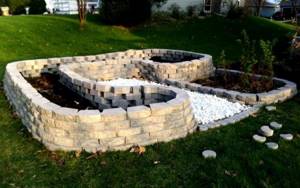
Plastic fencing
Plastic fencing for garden beds and flower beds is characterized by its low price, durability and ease of installation. They are resistant to rot, rodents, moisture and the aggressive influence of the soil, protect plantings from weeds and the germination of plant roots outside the garden bed. Plastic fences can withstand heavy rainfall and are extremely easy to care for.
For fencing beds, you can use the following options:
- garden PVC tapes,
- decorative plastic blocks,
- ready-made plastic containers,
- borders imitating wooden blocks or boards, natural stone,
- plastic bottles.
The simplest option is to install PVC tapes, which are simply buried in the soil around the perimeter of the plantings, protecting them from external negative influences. The tapes are suitable for heat-loving plants and vegetables, the design is easy to attach, and can be quickly assembled for the winter. A large selection of color schemes allows you to make your home area or plot with a vegetable garden bright and attractive.
Plastic blocks are ideal for flower beds, high vegetable beds or zoning lawn areas. The blocks imitate brick or natural stone, which allows you to create attractive borders in a variety of styles. Plastic structures are durable and lightweight, easy to care for, they can be used not only for open plantings, but also for greenhouses.
Ready-made plastic containers are used for small beds; they can be made in the form of decorative flowerpots or labyrinths. The installation of such structures is extremely simple, you select a place for installation, clear the area on which the container is placed (if necessary, it can be additionally fixed).
One of the simplest options is a fence made from ordinary plastic bottles dug into the ground with the neck down. To make the border durable, you can pour colored sand or small pebbles into the bottles before installation. Additionally, the outer part is tied, for which you can use wire or twine.
Advice from experienced gardeners
No matter how the beds are laid, when selecting and adjusting the material, it may be necessary to mechanically process the stones. This can be done in two ways:
- Leveling large pieces, smoothing out irregularities, removing excess protrusions and sharp corners is best done with a hammer weighing 2 - 3 kg.
- It is recommended to divide a large stone into several small ones using a 5 kg sledgehammer.
In order for the masonry to remain strong and resistant to various loads for a long time, you should take the advice of experienced gardeners and place the stones in accordance with the “cutting” rules:
- The stones of each row must be laid out in such a way as to prevent them from moving or shifting.
- In order for the masonry to be dense, the surface of the stones in contact with each other must be perpendicular to the force of gravity acting on them.
- It is necessary to avoid the appearance of through transverse and longitudinal vertical seams, which lead to the separation of the masonry into separate, unconnected columns.
When choosing a material and installation method, you need to think in advance about the goals and possibilities of doing such work yourself. Stone beds are very beautiful, but if the laying technology is not followed, the end result may differ significantly from what was expected. The rows may shift, then the beds will not retain their original shape and will look sloppy.
